As an Amazon Associate I earn from qualifying purchases.
Whenever I go to a sushi restaurant, I always order either hamachi sashimi or nigiri. Hamachi is Japanese yellowtail, and this fish is tailor-made for eating raw. Here’s how to make it, along with options for using other fish.

Sushi is amazing, but it is far harder to master than sashimi. Sushi has special rice and is formed into rolls or nigiri, skills that take years to master, while sashimi is basically slices of raw fish with rice on the side, or underneath.
In most places, your sashimi will come with wasabi, soy, shiso leaves, and often julienned daikon radish.
Of all the varieties of sushi fish, yellowtail is my favorite. Hamachi sashimi or nigiri are always a must-have because this fish is fatty, silky, mild and savory all at once. What’s more, yellowtail sashimi here in the United States is sustainable.
Hamachi and yellowtail, as well as kanpachi and hiramasa, are all jacks. Fast swimming, predatory fish with fatty, pink meat. Yes, there are subtle differences, but for the most part they are the same. The biggest difference is that if you get farmed hamachi sashimi, it will be fattier than wild American yellowtail.
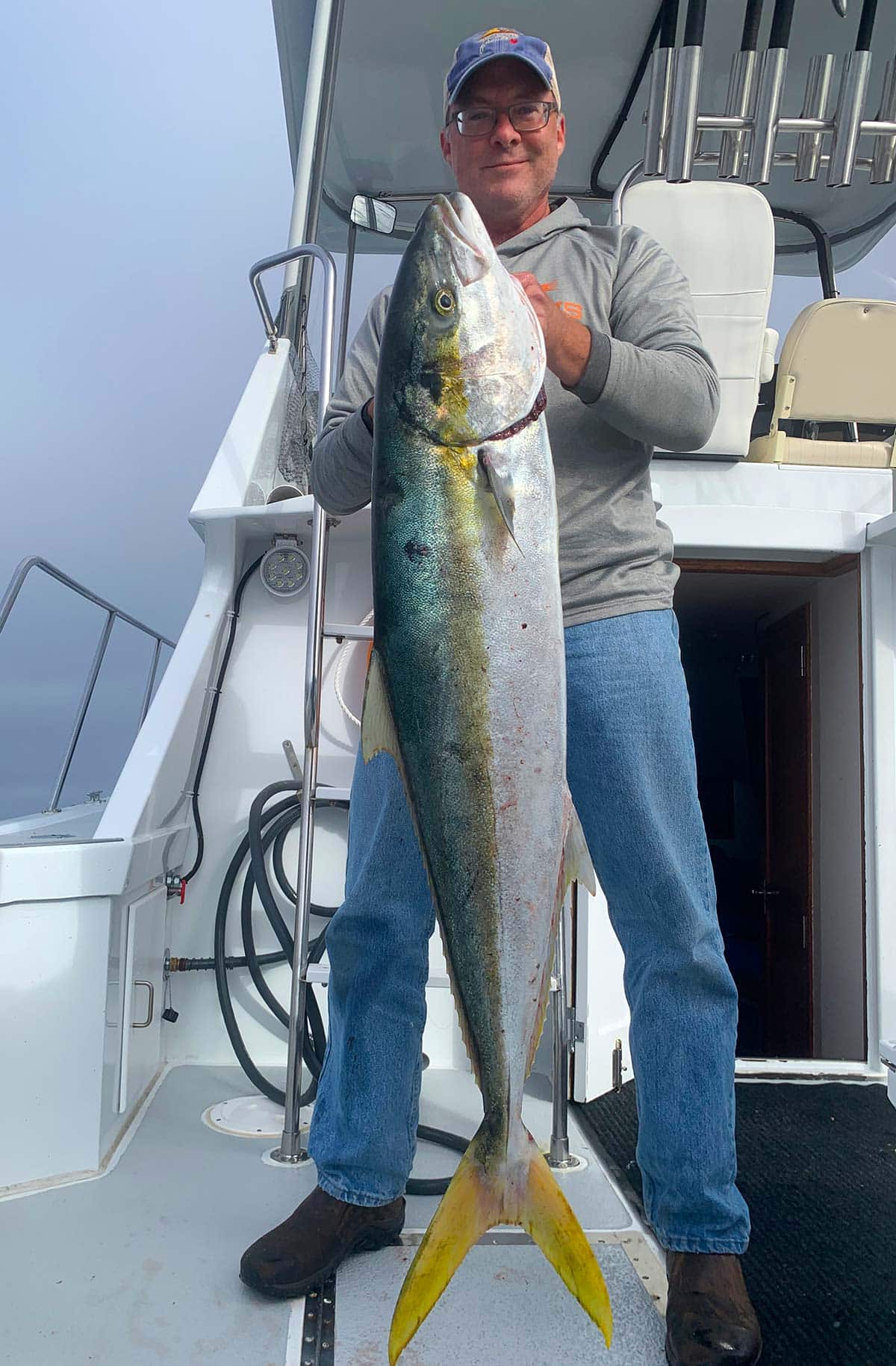
Getting Your Hamachi
As an angler, I catch yellowtail in Southern California. They are amazing fish, hard fighting and beautiful. The yellowtail we catch in the US and Mexico is Seriola ialandi, which, strictly speaking would make your yellowtail sashimi hiramasa sashimi in Japan. But like I said, they are very similar.
Yellowtail are almost never parasitized, so I feel comfortable about eating them raw, never frozen. But you should read my article on food safety for ceviche to get an idea about which fish you might want to do this with.
Chances are you will be buying your fish for hamachi sashimi, however. And in that case you can buy actual hamachi. I find it vacuum frozen in Asian markets, and if you have a really good Asian fish market, as we do here in Sacramento, they will fly it in from Japan.
Southern Californians can regularly buy yellowtail for yellowtail sashimi, and I’ve seen it a lot in Phoenix, too.
Alternatives to Hamachi Sashimi
OK, I get it: You live in the Midwest or East or South. What to do? If you are inland, look for those Asian markets and go to the freezer sections. Ditto for the Northeast.
But from about Virginia to the Gulf of Mexico, you have amberjack, which is very close. And while amberjacks can get wormy, those worms are large and very visible, so if you don’t see them, they’re not there.
Wahoo is another excellent option, as are any of the tuna species.
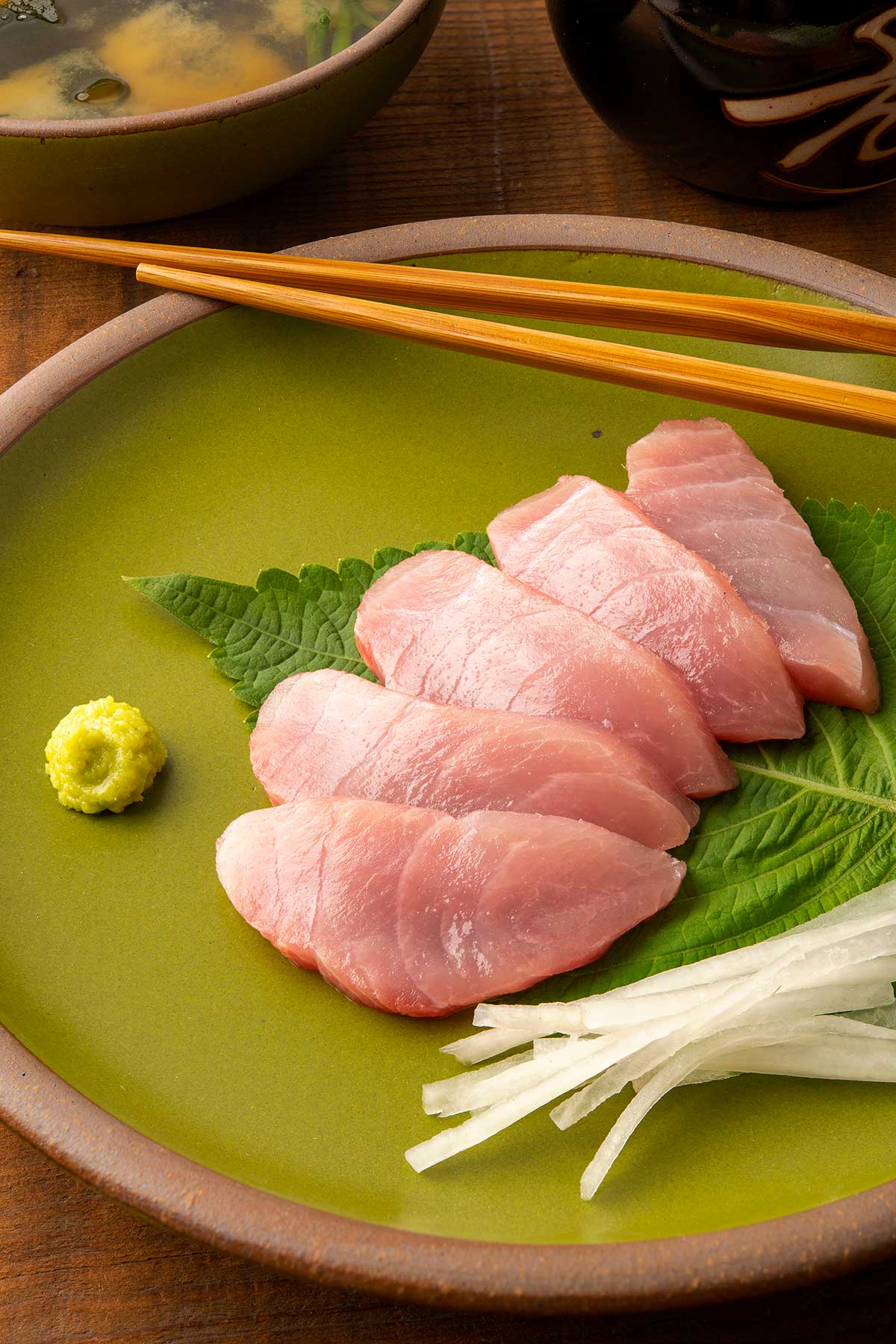
How to Cut Yellowtail Sashimi
Obviously hamachi sashimi is thinly sliced hamachi, right? Well, there’s a way to slice it right.
First, you need a long, very sharp knife. I have a sushi knife and I love it, but a long fillet knife that is as sharp as lightning will serve you well. In a pinch, your longest chef’s knife will be OK.
Why long? Because you cut fish for sashimi and sushi with one long slice where you draw the knife back towards you. Never saw through a piece of fish. Yellowtail are big fish (see picture above), so you need a long knife.
Always cut against the grain of the fish. If you cut with the grain, your hamachi sashimi will be nasty and chewy. Your best bet is to trim a block of yellowtail with an eye toward the eventual slices. In many cases, yellowtail smaller than what I caught in that picture above are easier to slice for sashimi.
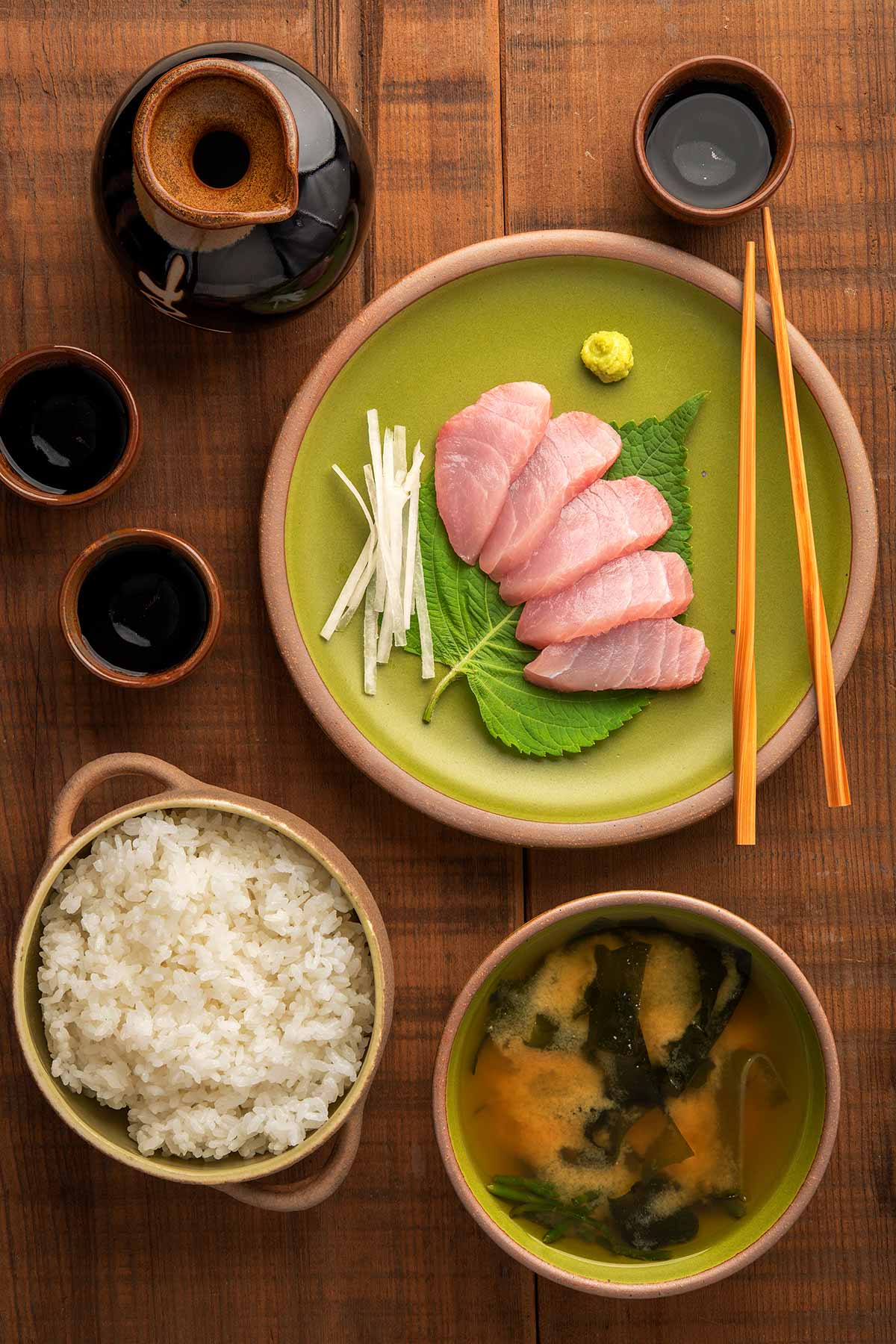
What to Serve with Hamachi Sashimi
In terms of how to serve your hamachi sashimi, I look to an expert, Shizuo Tsuji in his classic book Japanese Cooking: A Simple Art. If you are interested in Japanese cuisine, this is a great book.
First off, sashimi is an appetizer. You’re not supposed to gorge yourself on yellowtail sashimi, although I would be lying if I said I’ve never done that. Eat a few slices first, then enjoy your rice and miso soup.
The arrangement you see in the pictures is traditional: “Five or six rectangular slices rest like fallen dominoes against a bed of crisp, shred-cut giant white radish,” as Tsuji writes.
Shiso leaves are also common because their aroma cancels out any potential fishy smell. Wasabi adds a punch.
What about salt or soy? There is only one soy sauce appropriate for hamachi sashimi, and that’s white soy sauce, which paints on invisibly. Regular soy is too dark. But you have to get white soy sauce online or in a Japanese market, and those are rare outside California.
So my advice is to salt the block of yellowtail about 30 minutes before you slice it. That will season it well.
Fun Options
OK, so that’s the traditional way to serve hamachi sushi. But there’s no law against freestyling.
Keep in mind that yellowtail sashimi is the Japanese style of serving this fish raw. If you want to look to other cultures, try Italian crudo or Peruvian tiradito or Mexican aguachile. All are wonderful with yellowtail.
A thinly sliced chile here, a splash of citrus there. Really good, freshly ground black pepper or Sichuan pepper, freshly grated horseradish — or just a dot of fiery prepared horseradish — all will give your sashimi pop.
If you liked this recipe, please leave a ⭐️⭐️⭐️⭐️⭐️ rating and a comment below; I’d love to hear how everything went. If you’re on Instagram, share a picture and tag me at huntgathercook.
Yellowtail or Hamachi Sashimi
Ingredients
- 12 ounces yellowtail fillet
- Salt or white soy sauce
- Shiso leaves (optional)
- Wasabi
- 2 cups finely shredded daikon radish
Instructions
- Salt the block of yellowtail and set it in the fridge for 10 to 30 minutes. If you have the white soy sauce, no need for this.
- Using a long, sharp knife, slice the yellowtail against the grain into slices about 1/4 inch thick.
- If you are using shiso leaves, set them down and arrange the fish slices on them. If you have the white soy sauce, paint the fish with it now.
- Arrange the shredded daikon on the plate and give everyone a healthy dot of wasabi.
Nutrition
Nutrition information is automatically calculated, so should only be used as an approximation.
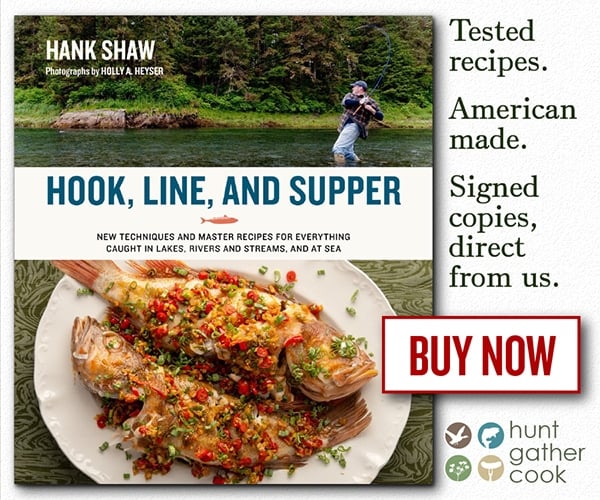

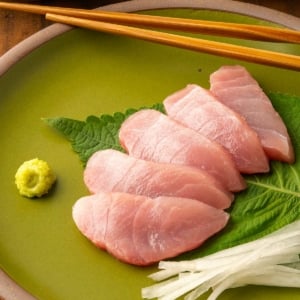
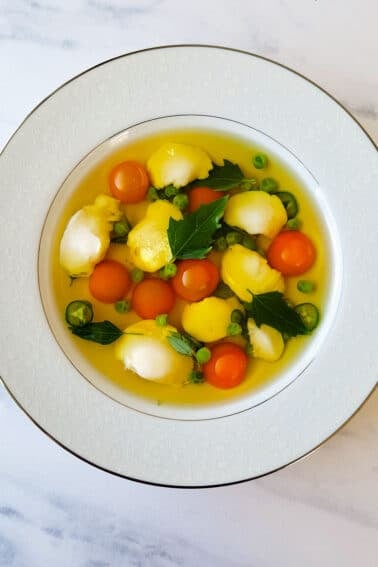
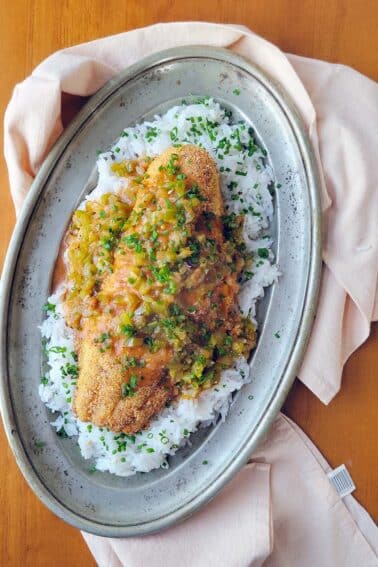
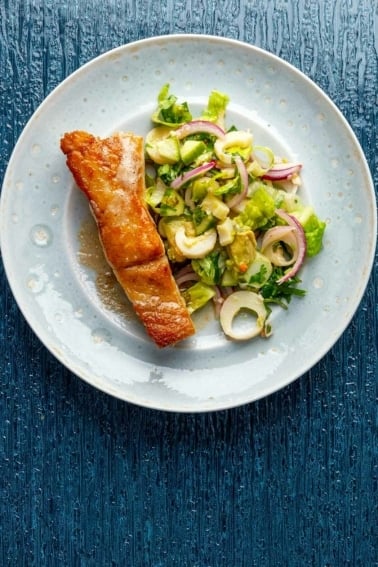
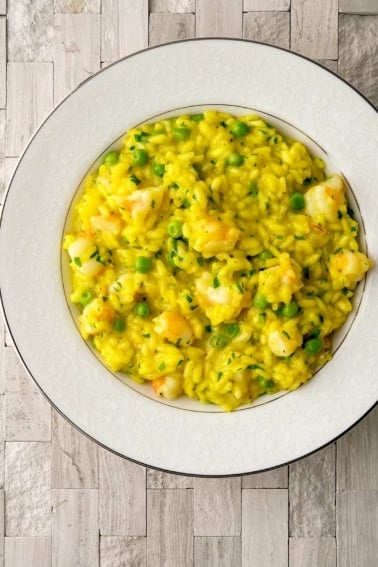
Hank … I would love to learn how YOU cut the fish into a block, and then watch you slice it for the sashimi……
Is there any way you could add a few pictures of that technique… or maybe you can recommend a site to show it?
Thanks !
Kristin: Thanks for the ask! I should definitely do that. When I do, I will update the post.
Hank – thanks for the knowledge as always. I actually never knew about white soy sauce until you schooled me here. One day I’ll make it out to so cal and catch one of these beasts!
Simple and lets the fish shine. It is a good thing to be spoiled with fresh and well taken care of fish.
Recently I traveled down the Sashimi road. When I returned home I found three new knives in my kitchen. The classic Japanese chef, a Santoku, and a custom Filet. Around the bend were instant miso soup, a tube of Wasabi, dried Seaweed, and some California Tule Lake horseradish. Some how they invited Chop sticks. little sauce trays, and a Sake
Ceramic container with matching cups. Your recipe completed my journey. Next is the new fishing rod and reel and a trip out on the Pacific Ocean. Whats an angler to do?
Any recommendation on a good sushi knife, or the one you’re using? I just returned from a 3-day trip out of San Diego and came home with about 45 lbs. of yellowtail fillets. Very happy to see the post today.
Eric: I have a nice one, but they are crazy expensive. I’ve done just as well with a long Dexter Russell filet knife.
What do you think about Albacore off Oregon and Washington? Should it be frozen before eating raw? I always have
Jim: I’ve always eaten albacore raw never frozen. They are not a heavily parasitized fish. None of the tuna are. But of course nothing is ever 100%.
Great recipe. When I go to Puerto Vallarta, I always charter a fishing trip. We always catch Mexican Tuna (whatever that is? a yellowtail?) and have fresh sashimi on the boat on the way back in. I throw soy sauce, salt and horseradish in my backpack, which always surprises the crew!!
I have a photo – could not insert.
Wild Yellowtail is not Hamachi but Buri Tuna. Hamachi Yellowtail is a subadult or adolescent younger more tender fish that is 100 percent farm raised in Japan ONLY and exported world wide as the much loved “Hamachi” of sushi restaurant fame. Much like Unakyu or farm raised fresh water Eel, Hamachi is fed a special diet and penned to reduce tougness while encouraging fatty muscle growth. This is similar to all captive raised farm animals and while your blog celebrates wild caught species, most of them are over fished and currently in process of collapsing if not already completely collapsed fisheries worlwide. It is also important to note that Buri or adult Yellowtail tuna is caught and consumed in Japan but not particulary valuable as a sashimi or sushi topping. The Japanese preference strongly favors the adolescent form of Yellowtail or so called Hamachi Yellowtail.
David: It’s a bit more complicated, but yes, you are right in that hamachi is a farmed product. First, yellowtail is in no way a tuna, and buri doesn’t suggest that it is. Also, every sushi expert I know tells me that buri or hiramasa are liked and appreciated in Japan as sushi, although yes, not as much as hamachi. Definitely a “wagu” vs. “whitetail” kind of difference — pampered vs. wild.
90 percent of al Hamachi and buri is farmed by some estimates and farmed Hamachi has a fat content up to 25% while wild Buri may approach 10 percent for cold water Buri cught in the winter months. Amberjack and Kampachi are also known as Buri and even Japanese chefs canlt tell the several species caught and sold as Buri apart. Sowild caught Buri doesn’t taste like farm raised Hamachi from Japan. And if you order Hamachi in the US, it is always flash frozen Japanese farmed raised as no one in the US will pay the extremely high prices for wild caught Buri caught in cold waters of northern Japan in wintertime. That is defintely not a southern Cali Amberjack.
And here is that longer answer cribbed from Sushi University. Note that I have never been offered super high quality wild caught wintertime Buri in Japan when the business entertainment expenses would have covered it easily. It just a very niche product available for a very short time to certain sushi bar customers And I have asked repeatedly about it when being entertained over business in Japan.
Concise and well written, as always. I especially appreciate the linkage to the bit on eating raw fish and parasites, which always comes up.